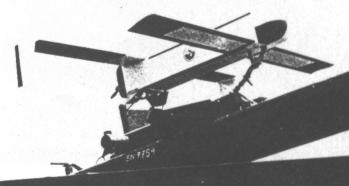Naval Research Lab LODED
In the early 1980s, the Naval Research Laboratory (NRL) studied the LODED (Long Duration Expendable Decoy) concept for a shipborne decoy mini-drone. A scaled-down prototype (slightly over half-scale), to which the following description applies, was built and test-flown.
The LODED test vehicle was of non-metallic construction, and was powered by a single low-power two-cycle piston engine driving a pusher propeller. It featured tandem wings of equal size. The forward wings controlled pitch, while the rearward pair was used for roll control and pitch trim. The rear wings also had vertical endplates for directional control. The wings could be quickly removed and installed for easy stowage of the drone within minimal volume. The vehicle was either launched from a catapult or took-off conventionally on its tricycle landing gear, and landed on a runway. In flight it was controlled via a radio command link.
 |
| Photo: via Jane's |
| LODED (sub-scale prototype) |
The sub-scale prototype successfully tested the handling characteristics of the design, including the low-speed loitering mode. However, the program was terminated after these tests, and the proposed full-scale LODED RPV, which was to have an endurance of 12 hours with a 18 kg (40 lb) payload, was not built.
Specifications
Data for LODED (sub-scale prototype):
| Length | 1.24 m (4 ft 1 in) |
| Wingspan | 1.73 m (5 ft 8 in) |
| Fuselage width | 17 cm (6.75 in) |
| Weight | empty: 5.9 kg (13 lb); max: 11.3 kg (25 lb) |
| Speed | > 61 km/h (38 mph) |
| Propulsion | Two-cycle piston engine; 0.75 kW (1 hp) |
Main Sources
[1] Kenneth Munson: "World Unmanned Aircraft", Jane's, 1988
Back to Directory of U.S. Military Rockets and Missiles, Appendix 4
Last Updated: 5 May 2004